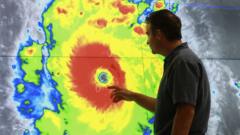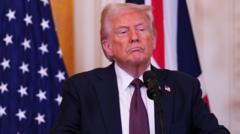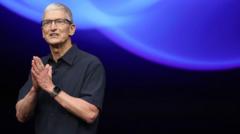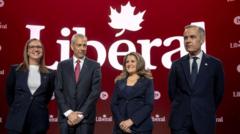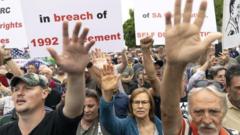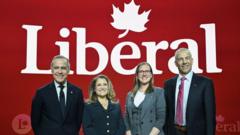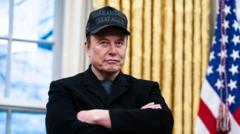Amid changing immigration policies, Indian dreamers continue to strategize for their American ambitions in uncertain times.
H-1B Visas: Navigating Anxieties Amid Trump’s Immigration Policies

H-1B Visas: Navigating Anxieties Amid Trump’s Immigration Policies
An exploration of the future challenges facing Indian students and professionals pursuing H-1B visas
Ashish Chauhan, a 29-year-old finance professional from India, is fervently planning to pursue an MBA in the US next year. However, he finds his aspirations overshadowed by the swirling controversy around H-1B visas, following a campaign by supporters of President Donald Trump, who has shifted from criticism to support of the visa program. The heated debate has triggered concerns among Indian nationals, who account for a significant majority of H-1B visas granted annually in the U.S.
The H-1B visa program has often been at the center of a contentious immigration debate. While it is hailed as a route for attracting global talent, critics argue that it undermines local labor. Trump's recent endorsement of the H-1B program contrasts with previous rulings that increased scrutiny and rejections for applicants, particularly impacting Indian nationals who now constitute over 72% of H-1B recipients.
The influx of Indian workers aligns with a broader trend in immigration, as 2023 marked the largest surge in two decades, resulting in immigrants making up 14% of the U.S. population, raising alarms among some about job competition. Indian students are flocking to American universities, with a record 331,602 enrolled for 2023-2024 – many heavily relying on loans for their education.
Chauhan expresses concern that ongoing resistance to H-1B visas might sour the reception of Indians in the US. "My ambitions can't be put on hold due to this turmoil," he remarks. Previous administrations’ tightening of H-1B visa criteria increased the denial rate significantly compared to the past, creating a tangled web of uncertainty for prospective visa holders.
Experts, like immigration scholar Stephen Yale-Loehr, emphasize the divided sentiments within the incoming Trump administration regarding the H-1B program. While some advocate for its reform, others propose stricter limitations on various immigration channels. It's still uncertain how the political landscape will impact these visa policies in the near future.
The H-1B visa has significantly influenced the demographic landscape of Indian-Americans in the U.S. Many seek this visa as a stepping stone towards eventual green card status, yet the prolonged waiting times for green cards create anxiety as over a million Indians remain in limbo.
Atal Agarwal, who once worked in the U.S. but returned to India due to visa constraints, highlights the precarious nature of the H-1B situation, emphasizing the need for a clear and expedited path to permanent residency. The link between H-1B visas and broader immigration concerns complicates the narrative further, clouding its perception amid fears of job displacement.
Amid escalating opposition to the H-1B program, allegations of exploitative practices have emerged, particularly against Indian IT firms that are major visa recipients. Nevertheless, industry advocates maintain that these workers are indeed contributing to the U.S. economy, highlighting their higher-than-average wages and their integration into American society.
As the landscape shifts with Trump's impending presidency, the Indian government is vocalizing its commitment to ensuring the future of the H-1B visa program which forms an essential part of the ever-growing U.S.-India technology partnership.
For aspiring students, guidance on immigration is paramount. Yale-Loehr advises that prospective students should focus on finding suitable educational institutions, as immigration reforms typically take time to materialize. Despite political undercurrents, the desire among Indian students and professionals for H-1B visas persists as they chase the elusive American dream.
The H-1B visa program has often been at the center of a contentious immigration debate. While it is hailed as a route for attracting global talent, critics argue that it undermines local labor. Trump's recent endorsement of the H-1B program contrasts with previous rulings that increased scrutiny and rejections for applicants, particularly impacting Indian nationals who now constitute over 72% of H-1B recipients.
The influx of Indian workers aligns with a broader trend in immigration, as 2023 marked the largest surge in two decades, resulting in immigrants making up 14% of the U.S. population, raising alarms among some about job competition. Indian students are flocking to American universities, with a record 331,602 enrolled for 2023-2024 – many heavily relying on loans for their education.
Chauhan expresses concern that ongoing resistance to H-1B visas might sour the reception of Indians in the US. "My ambitions can't be put on hold due to this turmoil," he remarks. Previous administrations’ tightening of H-1B visa criteria increased the denial rate significantly compared to the past, creating a tangled web of uncertainty for prospective visa holders.
Experts, like immigration scholar Stephen Yale-Loehr, emphasize the divided sentiments within the incoming Trump administration regarding the H-1B program. While some advocate for its reform, others propose stricter limitations on various immigration channels. It's still uncertain how the political landscape will impact these visa policies in the near future.
The H-1B visa has significantly influenced the demographic landscape of Indian-Americans in the U.S. Many seek this visa as a stepping stone towards eventual green card status, yet the prolonged waiting times for green cards create anxiety as over a million Indians remain in limbo.
Atal Agarwal, who once worked in the U.S. but returned to India due to visa constraints, highlights the precarious nature of the H-1B situation, emphasizing the need for a clear and expedited path to permanent residency. The link between H-1B visas and broader immigration concerns complicates the narrative further, clouding its perception amid fears of job displacement.
Amid escalating opposition to the H-1B program, allegations of exploitative practices have emerged, particularly against Indian IT firms that are major visa recipients. Nevertheless, industry advocates maintain that these workers are indeed contributing to the U.S. economy, highlighting their higher-than-average wages and their integration into American society.
As the landscape shifts with Trump's impending presidency, the Indian government is vocalizing its commitment to ensuring the future of the H-1B visa program which forms an essential part of the ever-growing U.S.-India technology partnership.
For aspiring students, guidance on immigration is paramount. Yale-Loehr advises that prospective students should focus on finding suitable educational institutions, as immigration reforms typically take time to materialize. Despite political undercurrents, the desire among Indian students and professionals for H-1B visas persists as they chase the elusive American dream.



